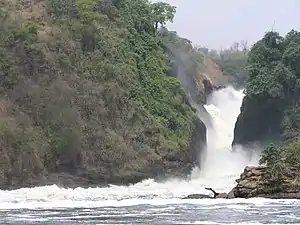Nero's exploration of the Nile
The Roman exploration of the Nile River under Nero was a Roman attempt to reach the sources of the Nile River. It was organized by emperor Nero in 60–61 AD.

History
Emperor Nero around 61 AD sent a small group of praetorian guards to explore the sources of the Nile River in Africa. He did this in order to obtain information for a possible conquest of Ethiopia, as was called Equatorial Africa (and everything south of Egypt) by the Romans. The Roman legionaries navigating the Nile from southern Egypt initially reached the city of Meroë and later moved to the Sudd, where they found huge difficulties in going further.
Seneca wrote about this exploration and detailed that the sources were from a big lake in central Africa, south of the swamp region now called "the Sudd" in South Sudan. But other Roman historians, such as Pliny, suggest that the exploration was done in order to prepare a conquest of Ethiopia by Nero's legions.[1]
However, the death of Nero prevented further explorations of the Nile as well as a possible Roman conquest south of their Roman Egypt.[2]
Some historians suggest that the Roman legionaries of Nero probably reached the Murchison Falls in Uganda (but there is a major controversy about this very difficult achievement).[3]
Accounts of Seneca and Pliny
Accounts are found in Seneca the Younger (Naturales quaestiones, VI.8.3) and Pliny (Natural History, VI.XXXV, p. 181-187):
The Roman legionaries navigating the Nile from southern Egypt initially reached the city of Meroe and later moved to the Sudd, where they found huge difficulties to going further.
From Meroe the Roman party travelled 600 miles up the White Nile, until they reached the swamp-like Sudd in what is now southern Sudan, a fetid wetland filled with ferns, papyrus reeds and thick mats of rotting vegetation. In the rainy season it covers an area larger than England, with a vast humid swamp teeming with mosquitoes and other insects. The only large animals in the Sudd were the crocodiles and hippos that occupied the muddy pools within its vast expanse. Those who entered this region had to endure severe heat and risk disease and starvation. The Sudd was discovered to be too deep to be crossed safely on foot, but its waters were also too shallow to be explored any further by boat. The Romans ‘reached an area where the swamp could only bear a small boat containing one person’. At this point the party despaired of ever finding a definite source for the Nile and turned back reluctantly to report their findings to the emperor in Rome. They had probably reached a position nearly 1,500 miles south of the Roman-Egyptian border.[4]
— Raoul McLaughlin
The small group of praetorian guards reported back to Nero that, "we personally saw two rocks from which an immense quantity of water issued", according to Seneca. Some modern historians, such as Giovanni Vantini, argue that this place is the Murchison Falls in northern Uganda, meaning that the Romans may have reached equatorial Africa, though this is debated.
Furthermore, historian David Braund wrote, in 2015, that probably Nero's expedition to the Nile's sources opened a new route toward the Indian Ocean, bypassing the dangers of piracy in the Red Sea area while allowing future Roman commerce toward India and Azania.[5]
See also
References
- Buckley, Emma; Dinter, Martin (3 May 2013). A Companion to the Neronian Age. John Wiley & Sons. p. 364. ISBN 9781118316535.
- Buckley & Dinter: A Companion to the Neronian Age
- Vantini, Giovanni (2004). Da dove viene l'acqua del Nilo? Ricerche e risposte di antichi scienziati. Piroga: volume 8, numero 23, pgs. 88-91 (url=http://www.volint.it/piroga/piroga10/nilo.pdf Archived 2018-01-14 at the Wayback Machine)
- Desert legionaries in Africa
- David Braund: Nero’s Nubian Nile, India and the rubrum mare (Tacitus, Annals 2.61)
Further reading
- Emma Buckley, Martin Dinter. A Companion to the Neronian Age. Publisher John Wiley & Sons. Oxford, 2013 ISBN 1118316533
- Kirwan, L. P. (1957). "Rome beyond The Southern Egyptian Frontier". The Geographical Journal. 123 (1): 13–19. doi:10.2307/1790717. JSTOR 1790717.
